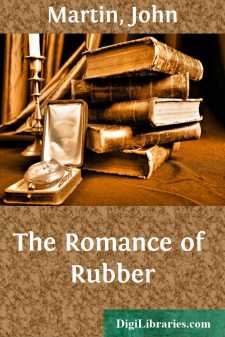Categories
- Antiques & Collectibles 13
- Architecture 36
- Art 48
- Bibles 22
- Biography & Autobiography 813
- Body, Mind & Spirit 142
- Business & Economics 28
- Children's Books 17
- Children's Fiction 14
- Computers 4
- Cooking 94
- Crafts & Hobbies 4
- Drama 346
- Education 46
- Family & Relationships 57
- Fiction 11829
- Games 19
- Gardening 17
- Health & Fitness 34
- History 1377
- House & Home 1
- Humor 147
- Juvenile Fiction 1873
- Juvenile Nonfiction 202
- Language Arts & Disciplines 88
- Law 16
- Literary Collections 686
- Literary Criticism 179
- Mathematics 13
- Medical 41
- Music 40
- Nature 179
- Non-Classifiable 1768
- Performing Arts 7
- Periodicals 1453
- Philosophy 64
- Photography 2
- Poetry 896
- Political Science 203
- Psychology 42
- Reference 154
- Religion 513
- Science 126
- Self-Help 84
- Social Science 81
- Sports & Recreation 34
- Study Aids 3
- Technology & Engineering 59
- Transportation 23
- Travel 463
- True Crime 29
The Romance of Rubber
by: John Martin
Categories:
Description:
Excerpt
CHAPTER 1
If you were asked, "What did Columbus discover in 1492?" you would have but one answer. But what he discovered on his second voyage is not quite so easy to say. He was looking for gold when he landed on the island of Hayti on that second trip. So his eyes were blind to the importance of a simple game which he saw being played with a ball that bounced by some half-naked Indian boys on the sand between the palm trees and the sea. Instead of the coveted gold, he took back to Europe, just as curiosities, some of the strange black balls given him by these Indian boys. He learned that the balls were made from the hardened juice of a tree.
The little boys and girls of Spain were used to playing with balls made of rags or wool, so you may imagine how these bouncing balls of the Indians must have pleased them. But the men who sent out this second expedition gave the balls little thought and certainly no value. Since Columbus brought back no gold, he was thrown into prison for debt, and he never imagined that, four hundred years later, men would turn that strange, gummy tree juice into more gold than King Ferdinand and Queen Isabella and all the princes of Europe ever dreamed of.
In the next century after Columbus's travels the Portuguese founded the colony of Brazil on the continent of South America. Their settlements were near the coast and they did not begin to explore the great Amazon region for a hundred years or so. The journey down this great river—which Theodore Roosevelt took so many years later—was first made by a Portuguese missionary, who found the same kind of gummy tree juice as that of the West Indies. But the natives along the Amazon had discovered that besides being elastic it was waterproof, and they were making shoes that would keep out water. You can picture a native boy spilling some of this liquid on his foot, then covering it, as he might with a mud pie, and when it dried wiggling his toes to find that, he had the first and perhaps the best fitting gum shoe that ever was made.
Little by little samples of this new substance found their way to Europe. It was another hundred years before thoughtful men believed it worth while to investigate this gum. In 1731 the Paris Academy of Science sent some explorers to learn about it. One of these Frenchmen, La Condamine, wrote of a tree called "Hevea"[1] "There flows from this tree a liquor which hardens gradually and blackens in the air." He found the people of Quito waterproofing cloth with it, and the Amazon Indians were making boots which, when blackened in smoke, looked like leather. Most interesting of all, they coated bottle-shaped moulds, and when the gum had hardened they would break the mould, shaking the pieces out of the neck, leaving an unbreakable bottle that would hold liquids.
[1] Hevea is pronounced Hee'-vee-uh. Caoutchouc is pronounced koo'-chook.
It was not long afterwards that Lisbon began to import some of these crudely fashioned articles, and it is said that in 1755 the King of Portugal sent to Brazil several pairs of his boots to be waterproofed....



